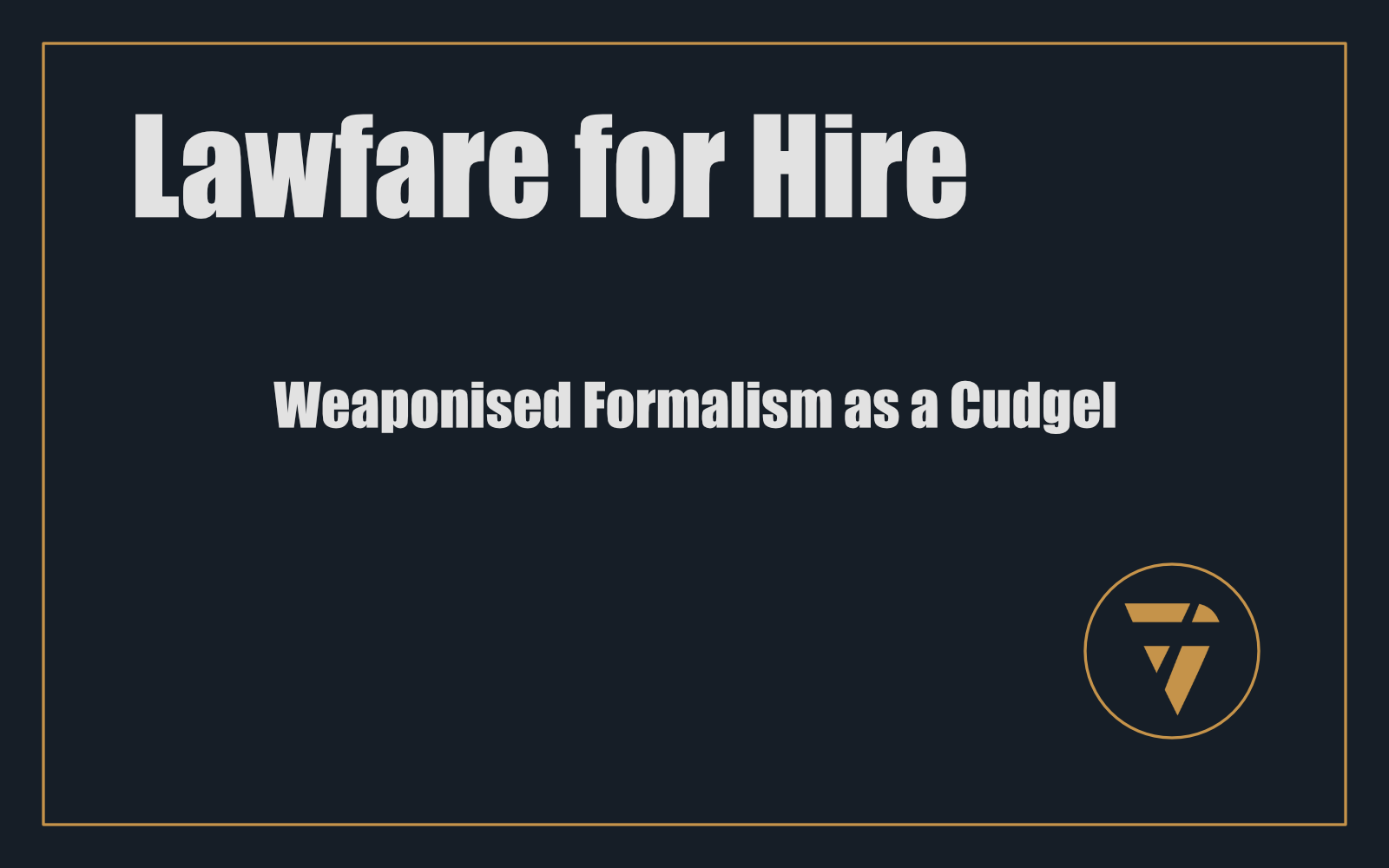Lawfare for Hire

Weaponised Formalism as a Cudgel
The system doesn’t care if you’re right. It cares if you can afford to prove it.
That’s the axis of modern law. Not truth. Not justice. Cost. Which means whoever holds capital holds consequence. And in the world of defamation threats, this isn’t theory—it’s architecture.
A threat letter like the one from Stillman LLP isn’t just a legal document. It’s a bullet wrapped in letterhead. It arrives dressed in formality, feigning professionalism, pretending to seek correction. But it’s not a conversation. It’s a performance of power.
Because what it really says is simple: We have money. You don’t. Stop talking. Give us what we demand. Or else.
I. The Machinery Behind the Mask
The doctrinal analysis is clean. Surgical. Perfect compliance with Section 13 of the Alberta Defamation Act. Full procedural elegance. It names the party, cites the statute, sets the timeline, and attaches a draft Statement of Claim like a pistol laid gently on the table.
In court, this letter is proper. Sort of.
But that’s the trap.
Because legal compliance doesn’t mean ethical legitimacy. Procedural perfection is not the same as moral high ground. And nowhere is that gap more dangerous than in the law of public discourse—where the price of speaking is measured not in truth, but in invoices.
This is the essence of weaponised formalism: using the outer structure of law to conceal its inner abuse.
II. Law as Theatre of Intimidation
Let’s call it what it is: economic warfare masquerading as civil procedure.
Stillman’s letter doesn’t seek redress. It seeks silence. Not a verdict, but a void. A removal of resistance, not a restoration of truth. And it does this by exploiting the architecture of defamation law—a system designed without economic parity in mind.
$5M in damages isn’t a real number. It’s a threat vector.
This isn’t about winning in court. It’s about winning by default. By pressure. By attrition. And the targets aren’t just defendants—they’re witnesses. Everyone watching. Everyone thinking of publishing. Everyone who now sees the price of scrutiny.
III. The Illusion of Access
Legal education teaches rights as if they’re symmetrical. It presents defences—truth, fair comment, public interest—as if they are accessible. But they’re not.
Because to assert a defence, you need money. And time. And counsel. And resolve.
The average Canadian defamation defence costs six figures before you even reach trial. And there is no Legal Aid. No insurance. No runway. Just the long, slow burn of personal savings and mental health.
So here’s the paradox: the law protects your right to speak. But only if you can afford to keep speaking.
IV. Strategic Litigation as Social Control
This isn’t a bug. It’s the point.
The legal system allows powerful actors to purchase silence through formal threat, backed by institutional credibility. The cease and desist letter becomes the mechanism—not of justice—but of censorship. And it’s enforceable not by force, but by fear.
This is SLAPP in its purest form: Strategic Lawsuits Against Public Participation. Not filed for remedy—but for chilling effect. Not meant to win—but to warn.
Because even if the claims are laughable, the process is not.
The pain is in the process.
V. What Lawyers Won’t Say
Here’s the hardest truth: the legal profession facilitates this.
Because most lawyers are trained to assess risk, not righteousness. To advise on exposure, not ethics. And the system rewards it. Billable hours rise. Clients are impressed. Reputation for aggression grows. And somewhere along the way, the idea of law as a public good is replaced with law as a client weapon.
Professionalism becomes complicity.
The system is self-reinforcing. Law societies won’t intervene. Courts won’t punish. And so it continues.
VI. What This Letter Really Teaches
Stillman’s letter should be studied—not as an example of legal clarity—but as a blueprint for suppression.
It teaches that free speech isn’t free. That the law doesn’t punish the powerful for misusing it—it empowers them. That democratic discourse can be erased, one PDF at a time.
And most importantly, it teaches that procedural compliance can be the most dangerous form of abuse—because it hides behind respectability.
VII. Your Leverage Isn’t in Law. It’s in Exposure.
This article isn’t a critique of lawyers. It’s a call to operators.
Because if you’re a founder, strategist, or partner in any arena where power flows unevenly, you need to understand how law is being deployed around you. Not as protection—but as perimeter.
If they’re sending threats, it means the narrative is working. The only reason they paid that lawyers bill, is because they are threatened. The spend shows the weakness.
So you don’t fold. You document. You share. You let the sunlight do what the system won’t.
Expose. Disarm. Repeat.
The Final Line
Stillman’s letter is not a legal event. It’s a test of belief.
Do you believe your voice is worth defending, even if the system won’t defend it?
Because that’s the real battlefield.
And silence is the only way they win.
This is how I assessed the letter, to gauge it's merit, strength, and position - against me.
Legal Analysis of Cease and Desist Letters: A Dual-Course Framework
Course 1: Doctrinal Legal Analysis - "Defamation Law in Theory"
University of Calgary Faculty of Law - Advanced Defamation Law
Course Description
An examination of defamation law principles through case study analysis, focusing on the technical requirements, procedural compliance, and theoretical frameworks governing cease and desist communications under Canadian law.
Learning Objectives
Students will be able to:
- Analyze defamation claims using established legal frameworks
- Evaluate procedural compliance with statutory notice requirements
- Apply traditional defamation defences to contemporary cases
- Assess the theoretical boundaries between legitimate legal action and improper threats
Weekly Structure
Week 1: Foundational Elements of Defamation
Core Concepts:
- Publication, identification, defamatory meaning, falsity
- Hill v. Church of Scientology - establishing Canadian defamation standards
- Statutory notice requirements under provincial defamation acts
Case Study Application - Stillman Letter:
- Technical compliance with Alberta Defamation Act s.13
- 14-day notice requirement properly invoked
- Clear identification of allegedly defamatory statements
- Formal demand structure follows established precedent
Week 2: Publication and Identification Elements
Core Concepts:
- What constitutes publication in digital media
- Standards for clear identification of plaintiffs
- Corporate vs. individual defamation claims
Case Study Analysis:
- Blog publication clearly establishes "publication" element
- Direct naming of Sam Mraiche satisfies identification
- Corporate plaintiff (MHCare) properly identified in business context
- Third-party readership presumed from public blog format
Week 3: Defamatory Meaning and Natural Ordinary Meaning
Core Concepts:
- Literal vs. inferential meaning
- "Would right-thinking members of society think less of the plaintiff?"
- Contextual interpretation standards
Case Study Analysis:
- Article's "corporate parasite" language arguably defamatory in natural meaning
- Business corruption allegations clearly defamatory if false
- "Economic warfare" terminology suggests improper business practices
- Innuendo claims regarding government influence require contextual analysis
Week 4: Truth and Fair Comment Defences
Core Concepts:
- Truth as complete defence
- Fair comment on matters of public interest
- WIC Radio Ltd. v. Simpson fair comment framework
Case Study Application:
- Defendant would bear burden of proving substantial truth
- Public interest in government contracting practices established
- Fair comment defence available if opinion based on true facts
- Distinction between factual allegations and opinion commentary critical
Week 5: Qualified Privilege and Public Interest
Core Concepts:
- Traditional qualified privilege categories
- Emerging public interest defence post-Grant v. Torstar
- Responsible communication standard
Case Study Analysis:
- Government contracting as matter of public interest established
- Responsible communication standard: did defendant verify facts?
- Public interest defence potentially available for government accountability discourse
- Malice would defeat privilege if proven
Week 6: Procedural Requirements and Strategic Considerations
Core Concepts:
- Statutory notice requirements across jurisdictions
- Strategic use of procedural compliance
- Cost-benefit analysis in defamation actions
Case Study Assessment:
- Letter demonstrates full procedural compliance
- Strategic advantage of technical perfection in intimidation
- 10-day information demand creates additional pressure
- Draft statement of claim attachment shows serious intent
Week 7: Damages and Remedies in Defamation
Core Concepts:
- General, special, and punitive damages
- Injunctive relief standards
- Quantifying reputational harm
Case Study Analysis:
- $3M general damages claim appears excessive without concrete losses
- $2M punitive damages suggests deterrent rather than compensatory focus
- Injunctive relief seeks prior restraint on speech - constitutional concerns
- Economic harm allegations require substantial proof
Week 8: Constitutional Considerations
Core Concepts:
- Charter s.2(b) freedom of expression
- Dagenais/Mentuck test for publication bans
- Balancing free expression with reputation protection
Case Study Application:
- Permanent injunction would constitute prior restraint
- Charter analysis required for broad speech restrictions
- Public interest in government accountability discourse
- Overbreadth concerns with blanket speech prohibition
Assessment Methodology
Technical Compliance Analysis (30%) Students evaluate whether the cease and desist letter meets all formal legal requirements under:
- Alberta Defamation Act statutory notice provisions
- Procedural rules for defamation actions
- Evidentiary requirements for defamation claims
Substantive Legal Analysis (40%) Comprehensive analysis of:
- Strength of defamation claim on merits
- Available defences and their likelihood of success
- Constitutional considerations affecting remedies sought
- Precedential support for legal theories advanced
Strategic Assessment (30%) Evaluation of:
- Effectiveness of legal strategy employed
- Alternative approaches available to plaintiffs
- Risk assessment for both parties
- Cost-benefit analysis of litigation vs. settlement
Expected Outcomes - Doctrinal Analysis
Strengths of Plaintiffs' Position:
- Full procedural compliance with statutory requirements
- Clear identification of allegedly defamatory statements
- Economic harm allegations properly pleaded
- Technical proficiency in legal drafting
Weaknesses of Plaintiffs' Position:
- Substantial truth defence potentially available
- Strong public interest in subject matter
- Constitutional concerns with injunctive relief sought
- Damages claims appear disproportionate to demonstrated harm
Overall Assessment: Technically competent legal action that meets formal requirements but faces significant substantive challenges from established defamation defences and constitutional free expression protections.
Course 2: Empirical Legal Analysis - "Law in Action: Strategic Litigation as Social Control"
University of Calgary Faculty of Law - Critical Legal Studies
Course Description
An examination of how legal institutions and procedures function in practice, with particular focus on the strategic use of litigation threats as mechanisms of social and economic control, regardless of underlying legal merit.
Learning Objectives
Students will be able to:
- Analyze the gap between formal legal rights and practical legal access
- Evaluate litigation as economic warfare rather than dispute resolution
- Understand power dynamics in asymmetric legal conflicts
- Assess the chilling effect of legal threats on democratic discourse
Weekly Structure
Week 1: SLAPP Suits and Strategic Litigation
Core Concepts:
- Strategic Lawsuits Against Public Participation
- Economic intimidation through legal process
- Chilling effects on public discourse
Case Study Application - Functional Analysis:
- $5M total damages claim designed to terrify rather than compensate
- Individual defendant vs. corporate plaintiff power imbalance
- Cost of legal defence exceeds most individuals' resources
- Letter functions as economic threat regardless of legal merit
Week 2: Access to Justice and Economic Barriers
Core Concepts:
- Cost barriers to legal defence in Canada
- Absence of effective anti-SLAPP legislation in Alberta
- Insurance and legal aid limitations
Case Study Reality Check:
- Defending defamation action costs $100,000-$500,000 minimum
- Individual blogger likely lacks resources for proper defence
- No legal aid available for defamation defence
- Corporate plaintiff can sustain prolonged litigation
Week 3: The Chilling Effect on Democratic Discourse
Core Concepts:
- Self-censorship as intended outcome
- Impact on government accountability journalism
- Broader suppression of public interest speech
Case Study Social Impact:
- Letter designed to silence criticism of government contracting
- Creates precedent discouraging similar investigations
- Chills speech on matters of legitimate public concern
- Demonstrates corporate capture of legal system
Week 4: Forum Shopping and Jurisdictional Strategy
Core Concepts:
- Plaintiff-friendly jurisdictions in Canadian defamation law
- Strategic choice of Alberta courts
- Jurisdictional challenges for out-of-province defendants
Case Study Strategic Analysis:
- Alberta chosen despite defendant residing in BC
- Alberta's more restrictive defamation law environment
- Travel and legal costs compound defendant's burden
- "Real and substantial connection" test easily manipulated
Week 5: Corporate Reputation Management Through Law
Core Concepts:
- Legal threats as public relations strategy
- Reputation laundering through litigation
- Corporate capture of legal discourse
Case Study Corporate Strategy:
- Legal action deflects from substantive corruption allegations
- Creates narrative of victimization rather than accountability
- Transforms public interest questions into "legal disputes"
- Uses law's legitimacy to shield from scrutiny
Week 6: Power Asymmetries in Legal Process
Core Concepts:
- Resource disparities between corporate and individual litigants
- Repeat player advantages in legal system
- Institutional bias toward wealthy plaintiffs
Case Study Power Analysis:
- Stillman LLP as repeat player in intimidation litigation
- Corporate plaintiff's unlimited litigation budget
- Individual defendant's vulnerability to economic pressure
- Law firm's reputation enhancement through aggressive tactics
Week 7: Regulatory Capture and Professional Ethics
Core Concepts:
- Law societies' failure to regulate intimidation tactics
- Professional ethics vs. zealous advocacy
- Self-regulation limitations in legal profession
Case Study Ethical Analysis:
- Letter potentially violates professional conduct rules
- No meaningful enforcement against intimidation tactics
- Legal profession's institutional interests align with corporate clients
- Ethical rules provide cover for unethical behaviour
Week 8: Democratic Implications and Systemic Critique
Core Concepts:
- Law as tool of elite social control
- Impact on democratic accountability mechanisms
- Structural reforms needed for access to justice
Case Study Democratic Analysis:
- Legal system serves to protect powerful from scrutiny
- Democratic discourse systematically suppressed
- Legal profession complicit in democratic degradation
- Reform requires structural rather than incremental change
Assessment Methodology
Empirical Impact Analysis (35%) Students document the actual effects of strategic litigation through:
- Survey of chilled speech following similar legal threats
- Economic analysis of litigation costs vs. typical defendant resources
- Documentation of self-censorship in government accountability reporting
Power Structure Analysis (35%) Examination of:
- Corporate advantages in litigation system
- Institutional biases favouring repeat players
- Economic barriers to meaningful defence
- Professional networks enabling strategic litigation
Reform Proposals (30%) Development of:
- Anti-SLAPP legislation recommendations
- Access to justice improvements
- Professional regulation reforms
- Democratic accountability protections
Expected Outcomes - Empirical Analysis
Functional Reality of Legal Action:
- Primary purpose is intimidation rather than compensation
- Success measured by silencing criticism, not winning in court
- Legal system facilitates rather than prevents abuse
- Democratic discourse systematically suppressed
Systemic Problems Revealed:
- Law serves elite interests over public interest
- Professional ethics ineffective against strategic abuse
- Access to justice exists in theory only
- Constitutional protections meaningless without practical access
Overall Assessment: Legal system functions as mechanism of social control, enabling powerful actors to suppress legitimate criticism through economic intimidation legitimized by formal legal process.
Comparative Analysis: Theory vs. Practice
Fundamental Tensions Revealed
1. Formal Rights vs. Practical Access
Theoretical Framework: The doctrinal analysis reveals robust theoretical protections for freedom of expression through fair comment, public interest defence, and constitutional guarantees. Legal theory suggests defendants have multiple viable defences against defamation claims involving government accountability.
Practical Reality: The empirical analysis demonstrates that theoretical rights are meaningless when defendants lack resources to assert them. A $100,000+ defence cost renders constitutional protections illusory for most individuals, creating a system where rights exist only for those wealthy enough to enforce them.
Critical Gap: Legal education focuses on doctrinal analysis while ignoring the economic barriers that make formal rights practically inaccessible, producing lawyers who understand legal theory but remain blind to systemic inequities.
2. Legitimate Legal Process vs. Economic Intimidation
Theoretical Framework: Doctrinal analysis treats the cease and desist letter as legitimate legal communication, technically compliant with statutory requirements and pursuing recognized legal remedies through proper channels.
Practical Reality: Empirical analysis reveals the letter's primary function as economic intimidation, designed to silence criticism through financial pressure rather than to obtain legitimate legal remedies.
Critical Gap: Legal formalism legitimizes abuse by focusing on procedural compliance while ignoring substantive purpose and effect, enabling systematic suppression of democratic discourse under cover of legal legitimacy.
3. Individual Legal Disputes vs. Systemic Social Control
Theoretical Framework: Doctrinal analysis treats this as an individual dispute between specific parties over particular statements, to be resolved through established legal processes.
Practical Reality: Empirical analysis reveals this as part of a systemic pattern of using legal process to suppress public interest discourse, with implications extending far beyond the immediate parties.
Critical Gap: Legal analysis typically examines individual cases in isolation, missing broader patterns of legal system abuse and their cumulative impact on democratic governance.
Methodological Implications
For Legal Education:
Traditional legal education's focus on doctrinal analysis produces lawyers capable of technical legal work but blind to law's social and political functions. Students learn to operate the machinery of legal oppression while believing they're serving justice.
For Legal Practice:
Practitioners trained only in doctrinal analysis become unwitting agents of systemic inequality, using technical legal skills to serve elite interests while believing they're engaged in neutral professional work.
For Democratic Governance:
Legal system's focus on formal compliance over substantive justice undermines democratic accountability by providing sophisticated mechanisms for powerful interests to escape scrutiny.
Synthetic Conclusions
The contrast between these analytical frameworks reveals that:
- Legal formalism serves elite interests by legitimizing abuse through procedural compliance
- Constitutional rights are illusory without economic access to enforcement mechanisms
- Professional legal education is systematically inadequate in preparing lawyers to recognize and address legal system abuse
- Democratic governance is undermined when legal process serves to shield power from accountability rather than facilitate it
This dual-course analysis demonstrates that understanding law requires examining both its formal structure and its practical function - and that the gap between theory and practice represents not accidental oversight but systematic design serving elite interests over democratic values.
The Stillman letter succeeds not because it represents good legal work, but because it effectively weaponizes legal formalism against democratic discourse - revealing law not as neutral arbiter of justice, but as sophisticated mechanism of social control.
This is what I’m working on. Tell me what you think, I enjoy the conversation! Subscribe and follow the work in real time.
Thanks!
B

They didn’t send a letter.
They fired a warning shot, dressed in legalese.
You don’t need a lawyer. You need leverage.
PS -

Inside the Weapon: Decoding the Stillman Letter Line by Line
This isn’t a cease and desist.
It’s a playbook for institutional intimidation.
Here’s what they don’t want you to see:
1. “We act for MHCare and Sam Mraiche”
They lead with alignment. Corporate and personal. Why? So any defence must attack both. It’s harder—legally and emotionally—to confront a named individual and a business simultaneously. Classic double-bind framing.
2. “The article is defamatory and harassing”
No citation. No quotes. No specifics. Just labels. This is pretext language, designed to prime fear before fact. They're not proving harm. They’re asserting power.
3. “This letter shall constitute notice under s.13 of the Defamation Act”
This is where the real trap sits. They trigger a 14-day statutory window—perfectly timed. This doesn’t mean they want to sue. It means they want you to blink. Because most won’t risk waiting.
4. “You are directed to provide…”
Now the demand turns. They want intel. Names. Links. Attribution. This isn’t just censorship—it’s surveillance. They want to know who helped you speak, so they can isolate and dismantle your support network. That was the cover anyway, this truly is just about them trying to pressure Nate Pike.
5. “Failure to comply will result in litigation”
No hedging. No room. Full threat. This is not about resolving a dispute. This is about removing a voice.
The Draft Claim Attachment
They include a Statement of Claim. Why? It’s psychological warfare. Most people never see a lawsuit in their life. Opening one—especially with seven-figure damage claims—triggers panic, even if the substance is nonsense.
Here’s the truth:
- Their claim is technically correct.
- Their intent is strategically abusive.
- Their method is economically exclusive.
- Their outcome is democratic suppression.
This is not rare. It is standard operating procedure for those who understand how to bend law into silence.
You don’t need law school.
You need architecture.
Here’s how to install counter-pressure:
- Document everything. Not for court. For narrative. Every receipt matters.
- Publish response, not defence. Let the public see the move.
- Decentralise the attack. Share with aligned voices. Multiply the risk for the aggressor.
- Architect resilience. If you rely on platforms you don’t control, you’re not sovereign.
Stillman’s letter is not a climax.
It’s an opening move.
And if you read it right, it’s not a threat—it’s an opportunity.
Deploy your narrative shield. Make it public. Make it loud. Make it last.






